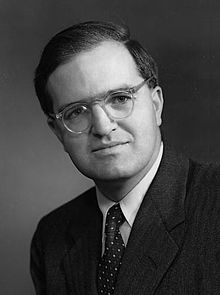Aage Bohr
| Aage Niels Bohr | |
|---|---|

Bohr in 1955
|
|
| Born |
19 June 1922 Copenhagen, Denmark |
| Died | 9 September 2009 (aged 87) Copenhagen, Denmark |
| Nationality | Danish |
| Fields | Nuclear physics |
| Institutions | |
| Alma mater | University of Copenhagen |
| Thesis | Rotational States of Atomic Nuclei (1954) |
| Known for | Geometry of atomic nuclei |
| Notable awards |
|
Aage Niels Bohr (Danish: [ˈɔːʊ̯ə ˌnels ˈboɐ̯ˀ]; 19 June 1922 – 9 September 2009) was a Danish nuclear physicist who shared the Nobel Prize in Physics in 1975 with Ben Mottelson and James Rainwater "for the discovery of the connection between collective motion and particle motion in atomic nuclei and the development of the theory of the structure of the atomic nucleus based on this connection". Starting from Rainwater's concept of an irregular-shaped liquid drop model of the nucleus, Bohr and Mottelson developed a detailed theory that was in close agreement with experiments. Since his father, Niels Bohr, had won the prize in 1922, he and his father were one of the six pairs of fathers and sons who have both won the Nobel Prize and one of the four pairs who have both won the Nobel Prize in Physics.
Aage Niels Bohr was born in Copenhagen on 19 June 1922, the fourth of six sons of the physicist Niels Bohr and his wife Margrethe Bohr (née Nørlund). His oldest brother, Christian, died in a boating accident in 1934, and his youngest, Harald, from childhood meningitis. Of the others, Hans became a physician; Erik, a chemical engineer; and Ernest, a lawyer and an Olympic athlete who played field hockey for Denmark at the 1948 Summer Olympics in London. The family lived at the Institute of Theoretical Physics at the University of Copenhagen, now known as the Niels Bohr Institute, where he grew up surrounded by physicists who were working with his father, such as Hans Kramers, Oskar Klein, Yoshio Nishina, Wolfgang Pauli and Werner Heisenberg. In 1932, the family moved to the Carlsberg Æresbolig, a mansion donated by Carl Jacobsen, the heir to Carlsberg breweries, to be used as an honorary residence by the Dane who had made the most prominent contribution to science, literature or the arts.
...
Wikipedia
